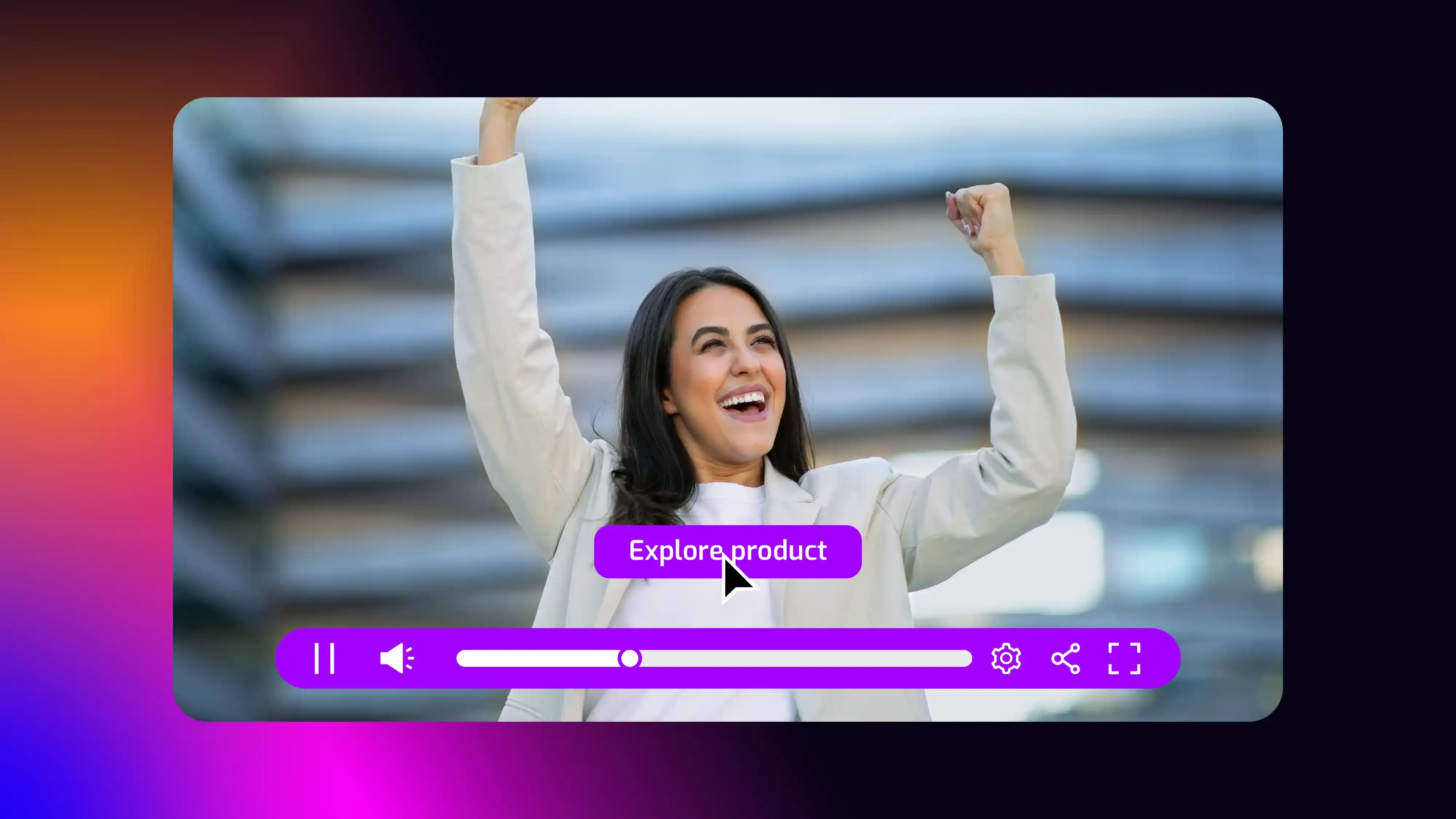Video marketing is one of the most powerful tools in a marketer’s toolkit. To deliver real value, videos need clear objectives such as lead generation, brand awareness, conversions, or retention. This guide shows how to set goals, choose formats, design CTAs, and track performance with video marketing analytics. It also shows how Cinema8 provides the hosting and analytics stack marketers need to build strategies that deliver results.
Why video marketing needs a clear objective
Creating strong video content starts with clear, measurable objectives. Without them, even the most polished content can miss the mark. Having a defined purpose within your video marketing plan provides clarity and ensures that content creation is aligned with outcomes. It also means your efforts support the metrics that actually matter to your business.
If you’re investing in video hosting tools for your content marketing, make sure it’s tied directly to key results: more qualified leads, improved engagement, better retention, or increased revenue. When those outcomes guide your decisions, every video becomes more targeted, more effective, and easier to measure.

How to create a video marketing strategy that drives results
Creating a goal-driven video strategy starts with the right foundation. In this section, we’ll walk through the essential steps to help you build a video content plan that supports your marketing objectives, engages your audience, and drives measurable results.
1. Build a video content plan around your goals
A strong video content plan is built in reverse: start with the goal, then work backward to determine the content. Different objectives call for different formats, channels, and calls-to-action.
For example:
- If your focus is lead generation, you might consider creating videos that include gated access, embedded lead forms, or calls-to-action that encourage sign-ups.
- If you’re working to build brand awareness, opt for short, shareable explainers or storytelling-driven campaigns.
- If your goal is to convert interest into action, prioritise product walkthroughs or case studies with embedded CTAs.
This kind of goal-first planning helps clarify what types of videos to create, where to distribute them, and how to measure success. It also ensures your creative and performance teams are aligned around a shared outcome–whether that’s attracting qualified leads, supporting a campaign, or driving conversions.
2. Choose the right video formats for your marketing strategy
The format of your video should reflect the outcome you're aiming to achieve. Not every video needs to go viral; some need to convert, educate, or retain. Choosing the right type helps make your video marketing strategy more efficient and purpose-driven.
Here’s how different formats align with different video marketing goals:
- Lead generation
Webinars, gated tutorials, and educational series that prompt viewers to share their contact information or register for access. - Brand awareness
Short-form explainers, product teasers, or storytelling pieces optimised for social media sharing and reach. - Conversions
Product demos, case studies, comparison videos, and shoppable video experiences that highlight value and guide the viewer toward immediate action. - Retention or onboarding
Step-by-step guides, customer support walkthroughs, or feature highlights that help users get more value from your product or service.
Strong marketing video production requires selecting the right format for the viewer’s stage in the journey and building each video around a clear next step. When formats are matched to intent, every video has a defined purpose and a higher chance of driving results.
3. Design strategic CTAs that drive results
A well-placed call-to-action (CTA) guides the viewer toward your marketing goal. It should be timed and structured to reflect both your objective and the viewer’s level of intent. Early-funnel content benefits from low-commitment CTAs like “Learn more” or “Explore features,” which keep viewers engaged without creating pressure.
As viewers move further down the funnel, you can shift to more action-oriented prompts—such as “Download the full guide” or “Register for our webinar.” For conversion-focused content, direct CTAs like “Start your free trial” or “Schedule a demo” provide a clear next step when interest is highest.
Smarter video hosting tools like clickable hotspots, branching paths, and in-video lead forms allow you to design these CTAs as part of the content experience. Instead of relying on the viewer to take action later, you create timely opportunities that feel natural and increase follow-through.
4. Track performance with video marketing analytics tools
Every video you publish should be tied to a measurable outcome and analytics are what confirm whether your content is actually working. A strong video marketing strategy relies on more than views; it’s about tracking the actions that matter.
Modern video marketing analytics tools let you go beyond surface-level metrics to understand how your content performs at each stage of the funnel. You can track viewer engagement, CTA clicks, retention, and conversion rates. These insights help you identify which videos drive real results, and where changes are needed.
Platforms like Cinema8 also allow you to test variations of your content—such as different video lengths, CTA placements, or interaction types—so you can refine your video marketing plan over time. By making data part of your creative process, you ensure that every video is contributing to your broader marketing goals.
5. Identify video distribution strategies that match your goals
The way you distribute your content is just as important as the content itself. Even the most well-crafted video won’t perform if it doesn’t reach the right audience in the right place.
Your distribution strategy should reflect the type of video and the goal it’s supporting. A digital marketing video designed to build awareness might be best suited for social platforms, where visibility and reach are high. A product walkthrough aimed at driving conversions may be more effective when embedded on your website or landing pages.
For B2B video marketing, channels like LinkedIn or email campaigns tend to deliver better engagement, especially for demos, case studies, or thought leadership content. And if your goal is lead generation, consider using dedicated video hosting platforms with embedded lead forms and gated access capabilities.
Each platform has its strengths, so understanding how they align with your marketing objectives helps you allocate resources effectively and get more value out of your video content.
What video hosting features help marketers optimise campaigns?
Marketing teams rely on specific hosting features to ensure video content supports every stage of the funnel. Branded hosting secures campaign control, SEO tools increase visibility, and lazy loading keeps landing pages fast. Agencies gain additional value from domain restrictions, analytics, and bulk upload options that simplify large video library management. To make these capabilities actionable, the following hosting solutions show how Cinema8 supports marketers with the tools they need to run faster, more effective campaigns.
- Video hosting for marketing teams: secure campaign hosting with branded environments that keep assets professional, measurable, and aligned with strategy.
- Video hosting for marketing agencies: manage large video libraries at scale with easy FTP upload, branded domains and analytics for comprehensive client reporting.
- Video SEO tools: improve search rankings with SEO-ready embeds that increase visibility and organic traffic.
- Lazy loading video: speed up landing pages by loading videos only when needed, reducing bounce rates.
- Best video hosting for embedding: integrate videos cleanly across websites while preserving load speed and brand presentation.
- Domain-restricted video embed: control where your videos appear, stop unauthorised sharing, and keep campaigns aligned with brand guidelines.
The benefits of video marketing and interactive tools
Video is one of the most effective formats for engaging audiences, communicating complex ideas, and driving action. It performs well across digital channels and is easily adaptable to different stages of the customer journey. When paired with interactive tools, it becomes even more powerful, enabling viewers to explore, respond, and take action within the content itself.
When used strategically, video and interactivity can:
- Drive more qualified leads through clickable CTAs, gated content, and embedded lead forms
- Increase brand awareness through shareable, story-driven content that encourages engagement
- Improve retention and product adoption using branching tutorials, in-video guidance, and knowledge checks with gamified processes
- Boost conversion rates by allowing viewers to explore products, compare options, and complete actions without leaving the video
These benefits are strongest when every video is aligned with a clear marketing goal. By combining engaging content with interactive features, brands can turn video from a branding asset into a measurable growth tool.
Final thoughts on aligning video with business outcomes
Effective video marketing isn’t about producing more content; it’s about producing the correct content with a clear purpose. When each video is aligned with a specific marketing goal, it becomes a tool for growth rather than just another piece of media in your content library.
Whether you're building awareness, generating leads, or improving customer engagement, a focused video content plan helps your team stay aligned, your message stay clear, and your results stay measurable.
Cinema8 gives you the tools to make that strategy work. We provide interactive features, analytics, lead capture capabilities, and many more features designed to turn video into a performance channel. If you're ready to connect your video strategy with real business outcomes, explore our plans or book a demo of our platform today.
